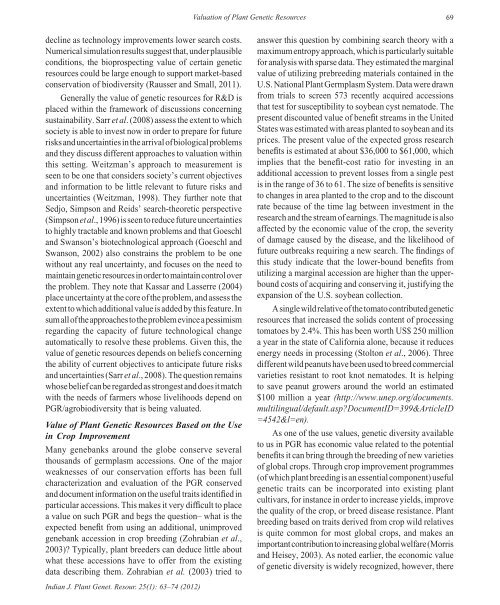indian society of plant genetic resources - Bioversity International
indian society of plant genetic resources - Bioversity International
indian society of plant genetic resources - Bioversity International
You also want an ePaper? Increase the reach of your titles
YUMPU automatically turns print PDFs into web optimized ePapers that Google loves.
decline as technology improvements lower search costs.<br />
Numerical simulation results suggest that, under plausible<br />
conditions, the bioprospecting value <strong>of</strong> certain <strong>genetic</strong><br />
<strong>resources</strong> could be large enough to support market-based<br />
conservation <strong>of</strong> biodiversity (Rausser and Small, 2011).<br />
Generally the value <strong>of</strong> <strong>genetic</strong> <strong>resources</strong> for R&D is<br />
placed within the framework <strong>of</strong> discussions concerning<br />
sustainability. Sarr et al. (2008) assess the extent to which<br />
<strong>society</strong> is able to invest now in order to prepare for future<br />
risks and uncertainties in the arrival <strong>of</strong> biological problems<br />
and they discuss different approaches to valuation within<br />
this setting. Weitzman’s approach to measurement is<br />
seen to be one that considers <strong>society</strong>’s current objectives<br />
and information to be little relevant to future risks and<br />
uncertainties (Weitzman, 1998). They further note that<br />
Sedjo, Simpson and Reids’ search-theoretic perspective<br />
(Simpson et al., 1996) is seen to reduce future uncertainties<br />
to highly tractable and known problems and that Goeschl<br />
and Swanson’s biotechnological approach (Goeschl and<br />
Swanson, 2002) also constrains the problem to be one<br />
without any real uncertainty, and focuses on the need to<br />
maintain <strong>genetic</strong> <strong>resources</strong> in order to maintain control over<br />
the problem. They note that Kassar and Lasserre (2004)<br />
place uncertainty at the core <strong>of</strong> the problem, and assess the<br />
extent to which additional value is added by this feature. In<br />
sum all <strong>of</strong> the approaches to the problem evince a pessimism<br />
regarding the capacity <strong>of</strong> future technological change<br />
automatically to resolve these problems. Given this, the<br />
value <strong>of</strong> <strong>genetic</strong> <strong>resources</strong> depends on beliefs concerning<br />
the ability <strong>of</strong> current objectives to anticipate future risks<br />
and uncertainties (Sarr et al., 2008). The question remains<br />
whose belief can be regarded as strongest and does it match<br />
with the needs <strong>of</strong> farmers whose livelihoods depend on<br />
PGR/agrobiodiversity that is being valuated.<br />
Value <strong>of</strong> Plant Genetic Resources Based on the Use<br />
in Crop Improvement<br />
Many genebanks around the globe conserve several<br />
thousands <strong>of</strong> germplasm accessions. One <strong>of</strong> the major<br />
weaknesses <strong>of</strong> our conservation efforts has been full<br />
characterization and evaluation <strong>of</strong> the PGR conserved<br />
and document information on the useful traits identifi ed in<br />
particular accessions. This makes it very diffi cult to place<br />
a value on such PGR and begs the question– what is the<br />
expected benefi t from using an additional, unimproved<br />
genebank accession in crop breeding (Zohrabian et al.,<br />
2003)? Typically, <strong>plant</strong> breeders can deduce little about<br />
what these accessions have to <strong>of</strong>fer from the existing<br />
data describing them. Zohrabian et al. (2003) tried to<br />
Indian J. Plant Genet. Resour. 25(1): 63–74 (2012)<br />
Valuation <strong>of</strong> Plant Genetic Resources 69<br />
answer this question by combining search theory with a<br />
maximum entropy approach, which is particularly suitable<br />
for analysis with sparse data. They estimated the marginal<br />
value <strong>of</strong> utilizing prebreeding materials contained in the<br />
U.S. National Plant Germplasm System. Data were drawn<br />
from trials to screen 573 recently acquired accessions<br />
that test for susceptibility to soybean cyst nematode. The<br />
present discounted value <strong>of</strong> benefi t streams in the United<br />
States was estimated with areas <strong>plant</strong>ed to soybean and its<br />
prices. The present value <strong>of</strong> the expected gross research<br />
benefi ts is estimated at about $36,000 to $61,000, which<br />
implies that the benefi t-cost ratio for investing in an<br />
additional accession to prevent losses from a single pest<br />
is in the range <strong>of</strong> 36 to 61. The size <strong>of</strong> benefi ts is sensitive<br />
to changes in area <strong>plant</strong>ed to the crop and to the discount<br />
rate because <strong>of</strong> the time lag between investment in the<br />
research and the stream <strong>of</strong> earnings. The magnitude is also<br />
affected by the economic value <strong>of</strong> the crop, the severity<br />
<strong>of</strong> damage caused by the disease, and the likelihood <strong>of</strong><br />
future outbreaks requiring a new search. The fi ndings <strong>of</strong><br />
this study indicate that the lower-bound benefi ts from<br />
utilizing a marginal accession are higher than the upperbound<br />
costs <strong>of</strong> acquiring and conserving it, justifying the<br />
expansion <strong>of</strong> the U.S. soybean collection.<br />
A single wild relative <strong>of</strong> the tomato contributed <strong>genetic</strong><br />
<strong>resources</strong> that increased the solids content <strong>of</strong> processing<br />
tomatoes by 2.4%. This has been worth US$ 250 million<br />
a year in the state <strong>of</strong> California alone, because it reduces<br />
energy needs in processing (Stolton et al., 2006). Three<br />
different wild peanuts have been used to breed commercial<br />
varieties resistant to root knot nematodes. It is helping<br />
to save peanut growers around the world an estimated<br />
$100 million a year (http://www.unep.org/documents.<br />
multilingual/default.asp?DocumentID=399&ArticleID<br />
=4542&l=en).<br />
As one <strong>of</strong> the use values, <strong>genetic</strong> diversity available<br />
to us in PGR has economic value related to the potential<br />
benefi ts it can bring through the breeding <strong>of</strong> new varieties<br />
<strong>of</strong> global crops. Through crop improvement programmes<br />
(<strong>of</strong> which <strong>plant</strong> breeding is an essential component) useful<br />
<strong>genetic</strong> traits can be incorporated into existing <strong>plant</strong><br />
cultivars, for instance in order to increase yields, improve<br />
the quality <strong>of</strong> the crop, or breed disease resistance. Plant<br />
breeding based on traits derived from crop wild relatives<br />
is quite common for most global crops, and makes an<br />
important contribution to increasing global welfare (Morris<br />
and Heisey, 2003). As noted earlier, the economic value<br />
<strong>of</strong> <strong>genetic</strong> diversity is widely recognized, however, there

















